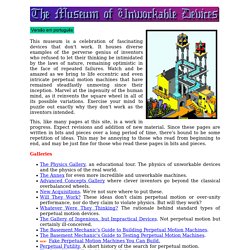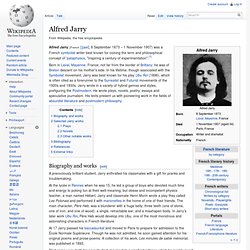

The Museum of Unworkable Devices. The Reading Room.

Related Galleries. Web resources. Deceptions by Peter Parsons. We don't talk much about deliberate contemporary scams and deceptions on these pages. We don't have to, for this excellent site debunks them thoroughly. "It may be perpetual motion, but it will take forever to test it. " Alfred Jarry. Alfred Jarry (French: [ʒaʁi]; 8 September 1873 – 1 November 1907) was a French symbolist writer best known for coining the term and philosophical concept of 'pataphysics, "inspiring a century of experimentation".[1] Born in Laval, Mayenne, France, not far from the border of Brittany; he was of Breton descent on his mother's side.

In his lifetime, though associated with the Symbolist movement, Jarry was best known for his play Ubu Roi (1896), which is often cited as a forerunner to the Surrealist and Futurist movements of the 1920s and 1930s. Jarry wrote in a variety of hybrid genres and styles, prefiguring the Postmodern. He wrote plays, novels, poetry, essays and speculative journalism. His texts present us with pioneering work in the fields of absurdist literature and postmodern philosophy. Biography and works[edit] A precociously brilliant student, Jarry enthralled his classmates with a gift for pranks and troublemaking. Père Ubu (later:Ubu Roi), from a drawing by Alfred Jarry. Ubu Roi. The title is sometimes translated as King Turd; however, the word "Ubu" is actually merely a nonsense word that probably evolved from the French pronunciation of the name “Herbert”, which was the name of one of Jarry’s teachers who was the satirical target and inspirer of the first versions of the play.[4] Jarry made some suggestions regarding how his play should be performed.

He wanted King Ubu to wear a cardboard horse's head in certain scenes, "as in the old English theatre", for he intended to “write a guignol". He thought a "suitably costumed person would enter, as in puppet shows, to put up signs indicating the locations of the various scenes. " He also wanted costumes with as little specific local colour reference or historical accuracy as possible.[5] Synopsis[edit] The story may at first glance seem merely frivolous—the obscene nonsense of schoolboys. 'Pataphysics. Jarry in Alfortville 'Pataphysics (French: 'pataphysique) is a philosophy or media theory dedicated to studying what lies beyond the realm of metaphysics.

Cabinet of Wonders. Pataphysics and Fictive Art. Or: How to Escape Into A Dream I looked at Chris Palmer's cool blog, KineticWorld, today (thanks Ranjit) and was intrigued with the entry on the Museé Patamécanique: a place, a website, an ideology of, as curator Neil Salley, puts it, "the science of imaginary solutions.

It is the underpinnings of our entire society. All words being equal, you can come up with any definition of it you like. " The term was coined by the brilliant 19th-century French writer Alfred Jarry (author of the play Ubu Roi), in his fictional Exploits and Opinions of Dr. Faustroll, Pataphysician, describes "the exploits and teachings of a sort of antiphilosopher who, born at age 63, travels through a hallucinatory Paris in a sieve and subscribes to the tenets of 'pataphysics. As Ranjit points out, the Boston Globe did an article on the Musée Patamécanique which they visited, describing the place thusly: Hooray for that!
This kind of art isn't that new. Links: Architecture. (Continued from last week) Here we are: some of the great plates from Ruins of the palace of the Emperor Diocletian at Spalatro in Dalmatia by Robert Adam, a Scottish architect who visited Split during the last forty years of Venetian rule (which ended in 1797).

As a consequence, I get to see aspects of the city as it was over two hundred years ago, before some of the more significant growth of the town. Of course, many of these images feel much more romantic and exciting than they probably really were. Adams came from a Romantic appreciation of ruin, so the elimination of unsightly modern clutter and the artful placement of fallen capitals, etc. is likely. As a result, my modern attempts to recreate his "views" with a camera are significantly lacking by comparison!
Also, please excuse the imperfect Photoshopping; I had neither the time nor the stitching-software which might have made for a more sophisticated look... still, you get the picture - so to speak. Institute of Failure.